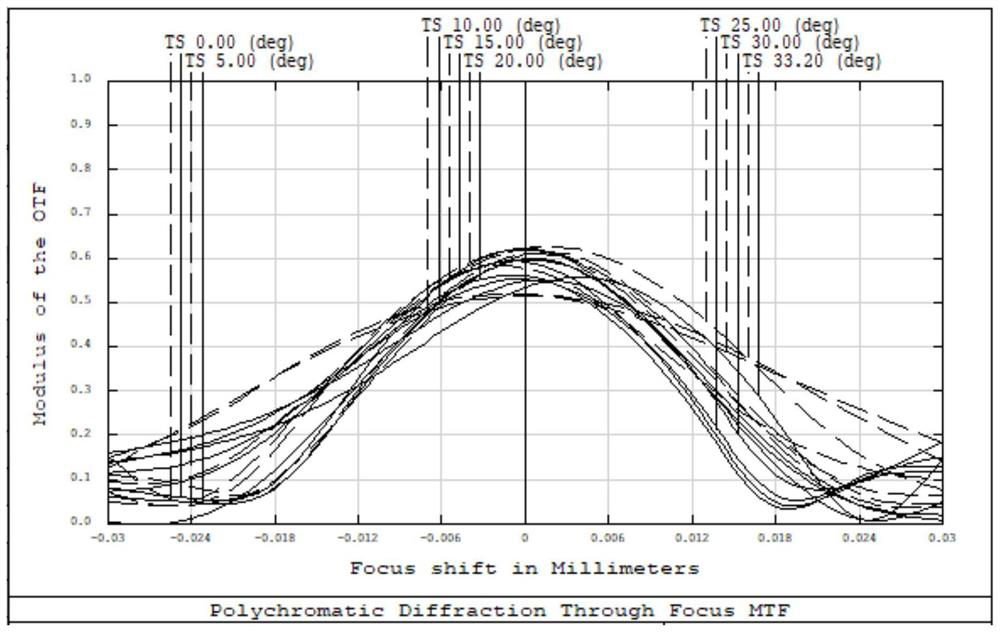Glass-plastic hybrid lens
A lens, plastic lens technology, applied in optics, instruments, optical components, etc., can solve the problems of inability to achieve large aperture, excellent high and low temperature performance, low definition, etc., achieve good manufacturability, good assembly tolerance, and guaranteed resolution Effect
- Summary
- Abstract
- Description
- Claims
- Application Information
AI Technical Summary
Problems solved by technology
Method used
Image
Examples
Embodiment approach 1
[0065] figure 1 It is a schematic diagram showing the structure of a glass-plastic hybrid lens according to Embodiment 1 of the present invention.
[0066] In Embodiment 1, the aperture FNO=1.6, and the effective focal length f=6.3mm. The stop S is set on the image side of the third lens 3, wherein the fourth lens 4 is a glass lens, and the rest of the lenses are plastic aspheric lenses.
[0067] The following table 2 lists the relevant parameters of each lens of the present embodiment, including surface type, radius of curvature, thickness, refractive index of material, Abbe number:
[0068] Face number surface type R value thickness Refractive index Abbe number S1 Aspherical 5.1668 1.212 1.534611 55.9821 S2 Aspherical 2.0095 3.8864 S3 Aspherical -7.1371 1.0688 1.61430 25.57289 S4 Aspherical -3.9581 0.0777 S5 Aspherical 3.1415 1.1257 1.639730 23.5289 S6(STO) Aspherical 5.6233 1.9461 S7...
Embodiment approach 2
[0076] Figure 6 It is a schematic diagram showing the structure of a glass-plastic hybrid lens according to Embodiment 2 of the present invention.
[0077] In Embodiment 2, the aperture FNO=1.4, and the effective focal length f=6.0mm. The diaphragm S is arranged between the third lens 3 and the fourth lens 4, wherein the fourth lens 4 is a glass lens, and the rest of the lenses are plastic aspheric lenses.
[0078] The following table 4 lists the relevant parameters of each lens of this embodiment, including surface type, radius of curvature, thickness, refractive index of material, Abbe number:
[0079] Face number surface type R value thickness Refractive index Abbe number S1 Aspherical 3.9668 1.212 1.534611 55.9821 S2 Aspherical 2.2095 2.7864 S3 Aspherical -4.1371 1.5688 1.534611 25.57289 S4 Aspherical -3.9581 0.0777 S5 Aspherical 4.1415 1.1257 1.669730 23.5289 S6 Aspherical 5.6233 1.0461 ...
Embodiment approach 3
[0087] Figure 11 It is a schematic diagram showing the structure of the glass-plastic hybrid lens according to Embodiment 3 of the present invention.
[0088] In Embodiment 3, the aperture FNO=1.6, and the effective focal length f=4mm. The diaphragm S is arranged between the third lens 3 and the fourth lens 4, wherein the fourth lens 4 is a glass lens, and the rest of the lenses are plastic aspheric lenses.
[0089] The following table 6 lists the relevant parameters of each lens of this embodiment, including surface type, radius of curvature, thickness, refractive index of material, Abbe number:
[0090]
[0091]
[0092] Table 6
[0093] In this embodiment, the aspheric surface data are shown in Table 7 below, K is the quadric surface constant of the surface, and A, B, C, D, and E are the fourth-order, sixth-order, eighth-order, tenth-order, and twelve-order respectively. Aspheric coefficients of order:
[0094] Face number K A B C D E S1 -2.0...
PUM
| Property | Measurement | Unit |
|---|---|---|
| Abbe number | aaaaa | aaaaa |
Abstract
Description
Claims
Application Information
 Login to View More
Login to View More - Generate Ideas
- Intellectual Property
- Life Sciences
- Materials
- Tech Scout
- Unparalleled Data Quality
- Higher Quality Content
- 60% Fewer Hallucinations
Browse by: Latest US Patents, China's latest patents, Technical Efficacy Thesaurus, Application Domain, Technology Topic, Popular Technical Reports.
© 2025 PatSnap. All rights reserved.Legal|Privacy policy|Modern Slavery Act Transparency Statement|Sitemap|About US| Contact US: help@patsnap.com



